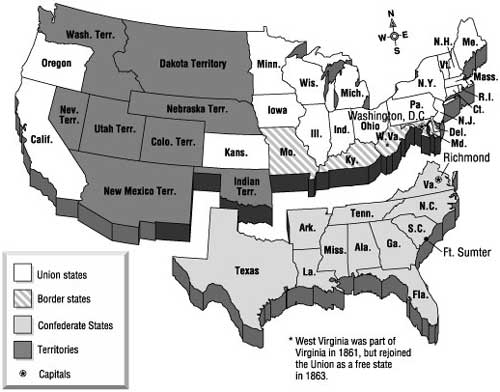Civil War Comparison
American Civil War Homepage
Civil War Comparison of the North and South
Northern and Southern States
Civil War Union and Confederate Comparisons
Total Populations, Manpower, Agriculture, Industry, Military, Casualties, Prisoners
Introduction
Civil War comparison between the North and South covers many aspects of the conflict. From comparing Union military and Confederate army capabilities; total Northern and Southern populations, manufacturing, manpower, and industry; list of weapons in the respective inventories of the North and South at the beginning of the war; army totals by year, with attrition rates; types of infantry, cavalry, and artillery weapons with totals; military strength and casualties per army and year; agriculture and industrial production; battle casualties, including killed, mortally wounded, missing in action, died of disease, prisoner of war deaths, and grand total deaths by state, as well as for the Union and Confederate military. This page contains additional pages with unique, rich facts, data, tables, charts, and statistics. Information has been compiled from US Census Bureau, Official Records of the Union and Confederate Armies, statisticians Fox, Dyer and Phisterer, The Union Army (1908), U.S. Military Academy, National Archives, National Park Service, Library of Congress, to numerous additional sources. Thanks for visiting and hopefully you will enjoy this site.
Civil War Comparison of the North and South
Map of the Northern, Southern, and Border States
The States of the American Civil War (1861-1865)
The Union, also known as the North, included the states of
Maine,
New York,
New Hampshire,
Vermont,
Massachusetts,
Connecticut,
Rhode Island,
Pennsylvania,
New Jersey,
Ohio,
Indiana,
Illinois,
Kansas,
Michigan,
Wisconsin,
Minnesota,
Iowa,
California,
Nevada, and
Oregon. Although Abraham Lincoln was President of the United States, during the American Civil War he was principally known as President of the Union. While
Maryland,
Delaware,
West Virginia,
Kentucky and
Missouri were known as
Border States, they remained under Union control. Because the Border States were critical to overall Union victory during the Civil War, separate and distinct statistics have been applied. President Lincoln, for example, said that to win the Civil War, "I hope to have God on my side, but I must have Kentucky!"
The Confederacy, aka South, included the states of
Texas,
Arkansas,
Louisiana,
Tennessee,
Mississippi,
Alabama,
Georgia,
Florida,
South Carolina,
North Carolina and
Virginia. Jefferson Davis was their President.
(Right) Map of Northern, Southern, and Border States. Two states were created during the four year Civil War. The western portion of Virginia seceded from Virginia and became the state of West Virginia on June 20, 1863, and Nevada received statehood on October 31, 1864. West Virginia was heavily recruited by both the Union and Confederate armies and was host to major battles and campaigns during the conflict. Nevada, according to the 1860 US census, had a mere population of 6,857, but its main contribution to the Union effort was financing the war with $400 million in silver. Nevada, per capita, was the wealthiest state in the Union.
Finance
Within the United States, the Union had $234,000,000 in bank deposit and coined money or specie while the Confederacy had $74,000,000 and the Border States had $29,000,000. See also
American Civil War: From Cost to Casualties
Populations
The population of the Union was 18.5 million. In the Confederacy, the population was listed as 5.5 million free and 3.5 million enslaved. In the Border States there were 2.5 million free inhabitants and 500,000 enslaved people. Since the North controlled all the Border States, its population was included in the Union. Therefore the Union population was 21,000,000 free persons and an additional 500,000 slaves, and the Confederacy totaled 5,000,000 free persons and an additional 3,500,000 enslaved persons.
North and South Comparisons during the Civil War
Table of Civil War Military Comparisons between the Union and Confederacy
Ag


